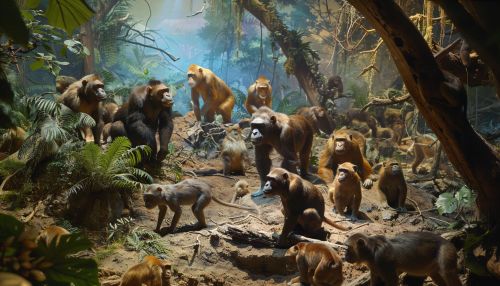Hominoid
Taxonomy and Evolution
Hominoids, also known as apes, are a group of primates that includes the gibbon, orangutan, gorilla, chimpanzee, bonobo, and human. The term "hominoid" is derived from the family name Hominidae, which includes the great apes and humans. This group is part of the superfamily Hominoidea, which also includes the lesser apes or gibbons.


The evolution of hominoids has been a topic of interest for many years. Hominoids are believed to have diverged from the Old World monkeys around 25 to 30 million years ago. The lesser apes, or gibbons, were the first to split from the main line of hominoids, around 18 to 12 million years ago. The remaining lineages of great apes and humans split from a common ancestor around 14 to 7 million years ago.
Anatomy and Physiology
Hominoids are characterized by their ability to move their arms in a rotating manner, a trait known as brachiation. This is due to the structure of their shoulder joints and the length of their arms, which are longer than their legs. Hominoids also have a broad chest and a short, stiff lower back, which aids in their upright posture. They have larger brains compared to other primates, and exhibit complex behaviors and social structures.
Behavior and Ecology
Hominoids exhibit a wide range of behaviors and ecological adaptations. They are primarily arboreal, living in forested areas, although some species such as humans have adapted to a wide range of environments. Hominoids are also known for their complex social structures. For example, gorillas live in groups led by a dominant male, while bonobos exhibit matriarchal societies. Hominoids also exhibit a range of communication behaviors, including vocalizations, facial expressions, and body postures.
Conservation
Many hominoid species are threatened or endangered due to habitat loss, hunting, and disease. Conservation efforts are ongoing to protect these species and their habitats. These efforts include habitat protection, anti-poaching measures, and captive breeding programs.
